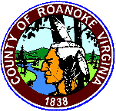The Roanoke County Board of Supervisors objected to omitting the American Indian from the redesign.
By Cody Lowe
With the launch of its new, redesigned website last week, Roanoke County also reached into its past.
The board of supervisors decided to give new prominence to the county seal, which is dominated by an American Indian image affectionately known as "Ralph."
"Ralph" and the seal were hardly visible anywhere on the old site, and a countywide Web redesign team had recommended not using him at all. That group wanted to "brand" the site with a "contemporary" Web logo featuring stylized mountains--no Indian.
The entire board of supervisors last summer took umbrage with that proposal, however. The mountain logo looked too much like Roanoke's symbol, they decided. "I like the seal," Supervisor Charlotte Moore said.
"This is not broken," supervisors Chairman Butch Church said at the time, predicting that county residents would resent the Indian's absence online, even if the seal did continue to be used on paper documents.
Consequently, the county got a slightly revised seal still featuring a bright red "Ralph" on its new website, which had a "soft launch" last weekend with little fanfare at www.roanokecountyva.gov.

And the new one:

Let's see...the skin color has gone from a slightly unnatural orange to a very unnatural brick red. The image is of a generic Indian, not a Cherokee. And the name "Ralph" is belittling; it treats the Indian as a mascot or pet, not as someone with a rich history and name of his own.
Tribes in Western Virginia
Most of the Cherokee lived south or west of Virginia, not in Virginia. So why not "honor" an actual Virginia tribe on the seal?
According to Wikipedia, here's who lived where Roanoke County is located:
Native American tribes in Virginia
[A] Monacan tradition holds that, centuries prior to European contact, the Monacan and the Powhatan tribes had been contesting part of the mountains in the western areas of today's Virginia. The Powhatan had pursued a band of Monacan as far as the Natural Bridge, Virginia, where the Monacan ambushed the Powhatan on the narrow formation, routing them. The Natural Bridge became a sacred site to the Monacan known as the Bridge of Mahomny or Mohomny (Creator). The Powhatan withdrew their settlements to below the fall line of the Piedmont, far to the east.
The Piedmont and area above the fall line were occupied by Siouan groups, such as the Monacan and Manahoac; Iroquoian peoples of the Cheroenhaka and Meherrin lived in what is now Southside Virginia. The region beyond the Blue Ridge (including West Virginia) was considered part of the sacred hunting grounds. Like much of the Ohio Valley, it had been depopulated by the Five Nations during the later Beaver Wars (1670–1700); its previous occupants are known from French Jesuit maps to have included the Siouan "Oniasont" (Nahyssan) and the Tutelo or "Totteroy," the former name of Big Sandy River—actually another name for the Yesan or Nahyssan.

The Cherokee may have lived in the western tip of Virginia that abuts Kentucky, but Roanoke County is close to the center of Virginia. I don't think it was Cherokee territory.
The Cherokee aren't all-purpose substitutes for "any Indian in the Southeast." If the seal has to "honor" someone, it should be "Mike Monacan" or "Ned Nahyssan," not "Ralph Cherokee."
For more on the subject, see Massachusetts Towns with Bad Seals and Indians Protest Massachusetts Seal.

No comments:
Post a Comment